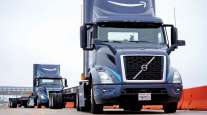Staff Reporter
VTNA Explores Ins, Outs of EV Truck Ownership

[Stay on top of transportation news: Get TTNews in your inbox.]
DUBLIN, Va. — Executives from Volvo Trucks North America detailed a comprehensive approach to help address fleet concerns about incorporating electric trucks into their operations during a recent media event.
“For a lot of people it’s still very new,” said Sam Ellis, a VTNA product manager, during the company’s Sept. 29 Volvo Electromobility Sales Summit. Hosted at the truck maker’s customer center, the summit featured a series of events to offer customers, stakeholders and the media firsthand experience with e-mobility in trucking.
In particular, Ellis noted that fleets need to understand the business case for adopting electric trucks, especially as it relates to maintenance costs and charging infrastructure. “A lot of fleets know what it costs to operate a truck per mile,” for diesel-powered equipment. That’s not yet the case for EVs. “This is new,” he said. “They don’t know what components are going to wear out faster, and things of that nature. So, there’s a fear there.”
Against that backdrop, transportation leaders are weighing whether to invest now, or wait and see how things do with other carriers.
“All these things are definitely on people’s minds,” Ellis said. “They want to see more people driving these on the road to ask those questions. ‘How’s this working for your fleet? Is it comparable to your diesel? Are you seeing benefits?’ Things like that.”
The company’s Gold Contract service agreement is one way it aims to support fleets looking to transition. It come standard on every Volvo VNR Electric, and covers maintenance needs.
“The Gold Contract covers all repairs and maintenance,” Ellis said. “The only exception to that is tires and glass. So, your body components are covered under this, your suspension, your brakes, your motors, your batteries, transmission, your rear axles, everything on the truck is covered, and the maintenance portion of it as well.”
Want more news? Listen to today's daily briefing above or go here for more info
Ellis added that parts and labor costs are locked in through the term of the contract, and multiple payment options are available. Remote monitoring and diagnostics are also part of the package, so fleets can be warned of issues and schedule repair work at one of Volvo’s growing list of EV-certified dealerships.
“We’re trying to protect the customer from any unplanned downtime,” Ellis said, stressing that there is no out-of-pocket expense to the fleet. “The dealer would submit everything just like regular warranty work.”
Volvo also is allowing data collection for further advance development of e-mobility. “We want to make sure our customers, as they’re asking those initial questions — how far can the truck go, where could it work, all those different things — that we’re helping them build confidence through connected services,” said Alexis Clemons, electro-mobility sales manager at Volvo Group, said. “We want to make sure that they feel confident in telling their driver they’re going to get back to base that night without having to call a tow truck.”
Volvo also is helping fleets with infrastructure support; in particular, helping them set up in-house charging stations while also working to help advance build-out of public charging, including a corridor of public stations along the West Coast.

Aguirre speaks at the event. (Connor D. Wolf/Transport Topics)
“We know that there’s a lot of legitimate questions that the customers have when it comes to charging,” said Manuel Aguirre, head of charging and infrastructure solutions at Volvo Energy. “We have significant experience at Volvo with our own installations as well as a number of our customers’ installations. Our mission here is to pass on that experience to our customer.”
Aguirre added that it’s about walking customers through the entire process of installing and maintaining their charging solutions. That includes setup as well as maintenance. Another big hurdle to overcome is how customers are going to pay for the charging stations.
“Even with the most generous incentives, there’s still a capital expenditure that will be budgeted when it comes to charging, and that’s where our financing solutions come into it,” he said. “We work with our customers to identify incentives that are available for them when it comes down to making this investment.”




